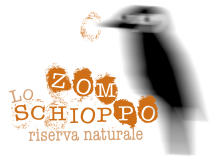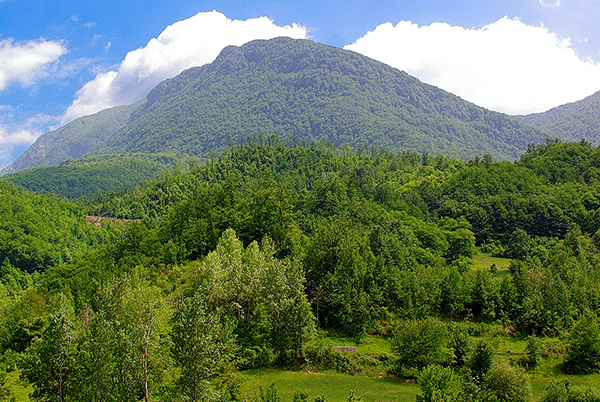The landscape plant also has some singularity: numerous individuals of “Rate” of enormous size, vegetating in a place not surprisingly called “Hauled”, ed un'alta rocciosa parete, that from which precipitates the waterfall, covered by several specimens of Holm, a tree in warmer environments, that here, between beech and hornbeam, has made a niche with ideal climatic conditions that allow it to live in its own shares is not.
Very impressive is a large forest of beech trees, located between the floor below the waterfall and the stream, where numerous examples are presented with impressive and winding forms, among the thousand streams of the brooks that run around.
THE BEECH
Family: Fagaceae
Appearance: deciduous tree with gray bark; deciduous
Height: 10-30-50 m
Leaves: opposite, elliptic, margin entire and wavy covered with white hairs; the upper surface is dark green, shiny, lint-free
Flowers: inflorescences (more flowers grouped together on a single stalk) beech are unisexual or a door only items the male reproductive (Occupational Health) and the female (Pistilli): the male flowers are in axillary, pendulous catkins, female flowers are isolated or in pairs, stalked and closed by the cupula thorny but not pungent
Fruits: beechnuts and elongated reddish (night) enclosed in a dome woody four-valve covered with spines herbaceous
Habitat: very common in the beech forests of beech in cold areas (Polysticho-Fagetum acerotosum pseudoplatani), those in the cooler areas in beech (Digitali-Fagetum) and in the beech forests of the less fresh beech (Aquifolium Fagetum cyclaminetosum)
Distribution in the Reserve: distributed in most of the forest land
Distribution in Italy: common on the Alps, Apennines and reliefs of Sicily
THE CERRO
Family: Fagaceae
Appearance: deciduous tree, erected, siunuoso, with young branches hairy
Height: 2-25 m
Leaves: Insertion alternates are elliptical or lanceolate, ruvide sui due lati, variously lobed or incised; the petiole is hairy
Flowers: inflorescences (more flowers grouped together on a single stalk) of turkey are unisexual or a door only items the male reproductive (Occupational Health) and the female (Pistilli): the male flowers form clusters (Arrangements) while the female flowers are sessile and isolated
Fruits: ovoid acorns covered half by a cupula with long scales, fibrose e incurvate
Habitat: very frequent in a downy oak and flowering ash (Pubescentis Cytiso-Quercetum)
Distribution in the Reserve: limited to a few areas of low altitude range
Distribution in Italy: common throughout Italy, except in Padania (ove è rara) e in Sardegna (ove manca)
THE CARPINO
Family: Corylaceae
Appearance: small tree with very dense foliage and conical; the foliage is deciduous
Height: 2-10 m
Leaves: lanceolate, acuminata, seghettate, rounded and symmetrical to the base; the listing has alternated (leaves distichous)
Flowers: inflorescences (more flowers grouped together on a single stalk) of hornbeam are unisexual or a door only items reproductive maschli (Occupational Health) and the female (Pistilli): both are cluster pendant (Arrangements), cylindrical in shape and green color mottled brown
Fruits: infructescenses (set of fruits derived dall'infiorescenza) formed by winged indehiscent fruits (acheni) closed in white bracts (modified leaves with a protective function), a sacco
Habitat: very frequent in a downy oak and flowering ash (Pubescentis Cytiso-Quercetum)
Distribution in the Reserve: band of high and low altitude
Distribution in Italy: very common throughout Italy, except in Padania, ove manca
THE LINDEN
Family: Tiliaceae
Appearance: deciduous tree; The bark is smooth and gray but with time it darkens and flakes
Height: 1-30 m
Leaves: alternate, heart-shaped with serrated edge; the underside of the hair has red-brown all'ascelle of the ribs at the base of the leaf blade
Flowers: together more flowers (inflorescences), pentamers and white, all at the same height while laid on peduncles of different length and inserted at different points of the main axis (corimbi)
Fruits: oval
Habitat: very common in the beech forests of the less fresh beech (Aquifolium Fagetum cyclaminetosum),
Distribution in the Reserve: very few individuals located
Distribution in Italy: Eastern Alps: common; Western Alps, Northern Apennines, Central Italy, Campania and Basilicata: rare
THE MAGGIOCIONDOLO
Family: Leguminosae
Appearance: deciduous shrub or small tree with erect branches, leaves and fruits free of fluff or only sparsely hairy
Height: 1-6 m
Leaves: composed, similar to those of clover (trifoliate), margin entire
Flowers: together more yellow flowers gathered on a single stalk (inflorescences) a grappolo
Fruits: buckets that open when ripe in two opposite lines longitudinally (vegetable), devoid of fluff with a wing along the suture
Habitat: very common in woods in core (Corylo-Populetum tremuli); frequent in beech forests of beech in cooler areas (Digitali-Fagetum), in the beech forests of the less fresh beech (Aquifolium Fagetum cyclaminetosum) and in the oak to oak and flowering ash (Pubescentis Cytiso-Quercetum)
Distribution in the Reserve: High Valley teve and part of the south-eastern
Distribution in Italy: Alps: common; Apennines: rare
L’ACERO
Family: Aceraceae
Appearance: tree with gray bark with longitudinal striations, deciduous
Height: 5-30 m
Leaves: palmate con 5 lobby
Flowers: together more flowers (inflorescences) gathered cluster on a single pedicle, outstanding (Arrangements) yellow-greenish
Fruits: dried with two wings arranged at 90 ° and forming an inverted V (Samara)
Habitat: characteristic species of beech forests of beech in cold areas (Polysticho-Fagetum aceretosum pseudoplatani)
Distribution in the Reserve: a patch of beech forest in lepardo
Distribution in Italy: Po Valley, Southern Apennines and Sicily: rare; common elsewhere
THE RATE
Family: Taxaceae
Appearance: bushy shrub but also tree; evergreen with a pyramidal crown. E’ a dioecious species or different individuals are male or female
Height: 5-20 m; live up to 300 year old, rarely up to 1000
Leaves: flat needles, soft, long up to 4 cm, arranged in opposite pairs; poisonous
Flowers: inflorescences (more flowers grouped together on a single stalk) rate are unisexual or a door only items the male reproductive (Occupational Health) and the female (Pistilli): the male flowers form catkins axillary yellow ovals while the female flowers are green, isolated and similar to the leaf buds
Fruits: berries apparent, carnose, red (arilli) that partially surround the black seed
Status: rare
Habitat: infrequent, only found in rocky environments (Potentilletum apenninae)
Distribution in the Reserve: present with old trees in the middle-top of the beech forest. Train of considerable interest
Distribution in Italy: very rare in the Alps, the Apennines, in Sicily and Sardinia
JUNIPER
Family: Cupressaceae
Appearance: evergreen shrub prostrate on the ground, well adapted to environments of high mountain; is a dioecious species that are different individuals, male or female
Height: 10-30 cm
Leaves: aghiformi, incurvate, just sharp and streaked beneath green-white, are arranged in groups of 3 at the same level on the branch (position in whorls)
Flowers: male and female small and inconspicuous
Fruits: after the second year are produced pseudobacche (galbuli) black-blue
Habitat: species characteristic of altitude grasslands of ridges and peaks(Carice humilis-Seslerieteum apenninae)
Distribution in the Reserve: present beyond the limit of the beech
Distribution in Italy: common in the Alps, the Northern Apennines, Central and Sardinia.


